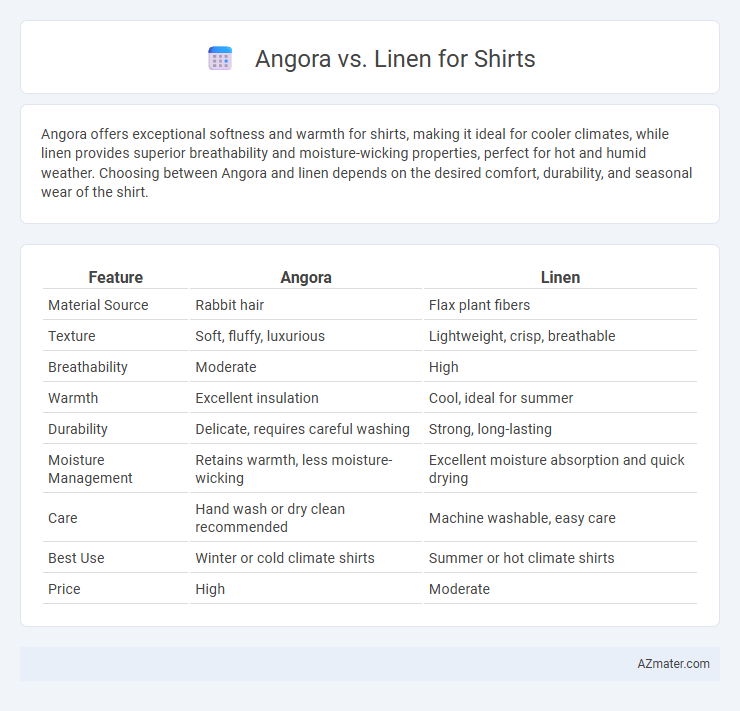Angora offers exceptional softness and warmth for shirts, making it ideal for cooler climates, while linen provides superior breathability and moisture-wicking properties, perfect for hot and humid weather. Choosing between Angora and linen depends on the desired comfort, durability, and seasonal wear of the shirt.
Table of Comparison
| Feature | Angora | Linen |
|---|---|---|
| Material Source | Rabbit hair | Flax plant fibers |
| Texture | Soft, fluffy, luxurious | Lightweight, crisp, breathable |
| Breathability | Moderate | High |
| Warmth | Excellent insulation | Cool, ideal for summer |
| Durability | Delicate, requires careful washing | Strong, long-lasting |
| Moisture Management | Retains warmth, less moisture-wicking | Excellent moisture absorption and quick drying |
| Care | Hand wash or dry clean recommended | Machine washable, easy care |
| Best Use | Winter or cold climate shirts | Summer or hot climate shirts |
| Price | High | Moderate |
Introduction to Angora and Linen Fabrics
Angora fabric, derived from the Angora rabbit, is prized for its exceptional softness, warmth, and lightweight feel, making it an ideal choice for luxurious shirts. Linen, made from flax fibers, is renowned for its breathability, moisture-wicking properties, and durable yet lightweight texture, perfect for summer wear. Both fabrics offer unique benefits: Angora excels in insulation and comfort, while linen provides superior ventilation and a natural crisp look.
Key Differences Between Angora and Linen
Angora fabric, derived from Angora rabbit wool, offers exceptional softness, warmth, and a luxurious texture, making it ideal for cozy, cold-weather shirts. Linen, made from flax fibers, is breathable, lightweight, and highly moisture-wicking, providing superior comfort in hot and humid conditions. The key differences lie in angora's insulating properties and delicate care requirements versus linen's durability, natural breathability, and wrinkle-prone nature.
Comfort and Feel: Which is Softer?
Angora fabric offers an exceptionally soft and luxurious feel, thanks to its fine, silky fibers derived from Angora rabbits, providing superior warmth and a plush texture ideal for cozy shirts. Linen, made from flax fibers, is lightweight and breathable, promoting excellent moisture-wicking and a crisp, slightly rougher texture that softens over time with wear. For unmatched softness and warmth, Angora is preferable, while linen excels in breathability and cool comfort during warmer seasons.
Breathability and Moisture Management
Angora fibers provide excellent insulation but have limited breathability and moisture-wicking properties compared to linen, making linen a superior choice for breathability and moisture management in shirts. Linen's natural fiber structure allows for maximum airflow and quick evaporation of sweat, keeping the wearer cool and dry in hot and humid conditions. Angora shirts excel in warmth and softness but lack the effective moisture control that linen offers, making them less ideal for moisture-intensive activities.
Durability and Longevity Comparison
Angora fibers, derived from Angora rabbits, provide exceptional softness but have lower durability and tend to pill with frequent wear, making them less ideal for long-lasting shirts. Linen, made from flax fibers, offers superior strength and breathability, ensuring shirts maintain integrity and appearance even after many washes. For durability and longevity, linen shirts significantly outperform Angora, remaining resilient and shape-retentive over time.
Style and Appearance for Shirts
Angora shirts offer a luxurious, soft texture with a subtle sheen that exudes elegance and warmth, making them ideal for sophisticated, winter-ready wardrobes. Linen shirts showcase a crisp, breathable fabric with a natural, slightly textured appearance, perfect for casual, summer styles and a relaxed, airy look. The choice between Angora and Linen significantly impacts the shirt's style, with Angora leaning toward formal refinement and Linen embracing effortless, breathable comfort.
Care and Maintenance Requirements
Angora shirts require gentle hand washing with cold water and mild detergent to preserve the soft fibers and prevent felting, while linen shirts are more durable and can typically be machine washed on a gentle cycle. Angora is prone to shedding and can be damaged by heat, so air drying and avoiding direct sunlight are essential, compared to linen's ability to withstand higher temperatures and quicker drying times. Proper storage in breathable garment bags helps maintain angora's delicate texture, whereas linen benefits from being ironed slightly damp to maintain its crisp appearance without damage.
Eco-Friendliness and Sustainability
Angora fibers are renewable and biodegradable, offering excellent insulation with minimal chemical processing, but their production raises animal welfare concerns and requires strict ethical sourcing to ensure sustainability. Linen, derived from flax plants, is highly eco-friendly due to its low water and pesticide requirements, biodegradability, and ability to grow in poor soils, making it a top choice for sustainable fabrics in shirts. Prioritizing linen supports regenerative agriculture and reduces environmental impact, while responsible Angora sourcing can balance softness and warmth with eco-conscious principles.
Cost Considerations: Angora vs. Linen
Angora shirts tend to be more expensive due to the labor-intensive process of harvesting Angora fiber and its rarity compared to linen. Linen is generally more affordable, sourced from flax plants with a more sustainable and widely available production process. When budgeting for shirts, choosing linen offers a cost-effective option, while Angora provides a luxury investment with higher price points.
Best Choice for Different Occasions
Angora shirts offer exceptional warmth and softness, making them ideal for cooler climates and formal occasions where comfort meets luxury. Linen shirts provide excellent breathability and moisture-wicking properties, perfect for hot weather and casual or outdoor events. Selecting between Angora and Linen depends on the occasion's temperature and formality, with Angora suited for winter gatherings and Linen for summer outings.

Infographic: Angora vs Linen for Shirt
 azmater.com
azmater.com